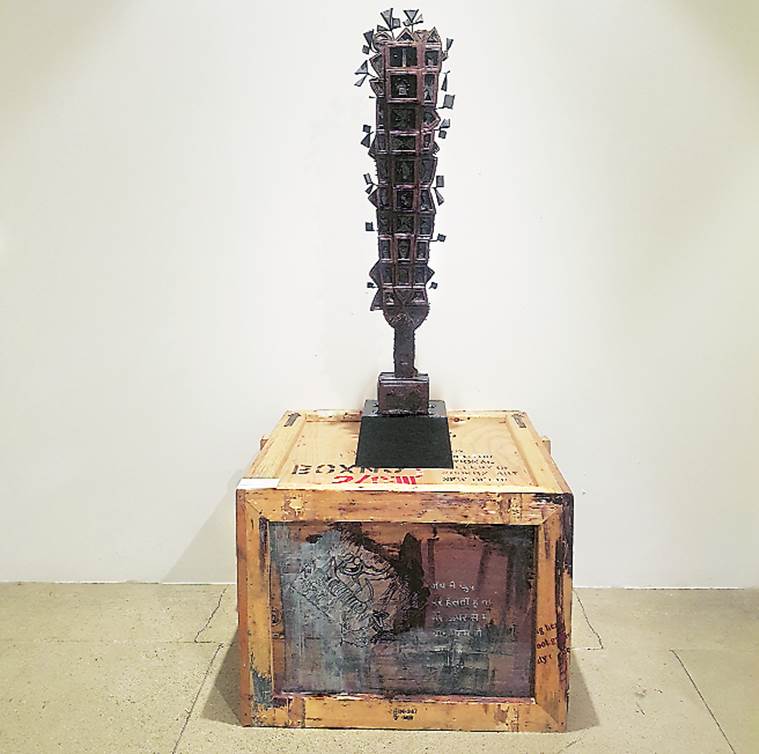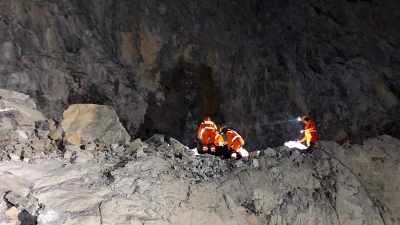 Works from the exhibition. Express photo by Geetika Bhandari
Works from the exhibition. Express photo by Geetika Bhandari
With just an hour to go for the exhibition to be formally inaugurated, as one got a sneak peak inside the galleries at the National Gallery of Modern Art (NGMA), it felt like a work-in-progress. In all the five rooms of the old wing, there were wooden trucks waiting to be opened, and one wondered how deadlines would be met. But when the exhibition opened, the reality of it unfolded. In a unique display, the 22 sculptures were mounted on wooden trunks that had preserved them for so long.
“These boxes have witnessed the journey of each of these sculptures. They have different addresses, dates and stamps on their surfaces, which says a lot about where these works have travelled and how have they done so far,” says Adwaita Gadanayak, Director-General, NGMA, who has conceptualised the display. He adds, “Like we take out heirloom from trunks every few years, look at our priced possessions and put them back, similarly, these artworks are our priced possessions.”

The exhibition, aptly titled “Itihaas”, marks 63 years of the institution’s existence, and the 22 sculptures on display are by 22 iconic artists whose works featured in the NGMA’s inaugural exhibition on March 29, 1954. Besides sculptures, it comprises drawings, paintings and random notes by the same set of artists, taking the total number of displayed items to more than hundred.
Story continues below this ad
 Works from the exhibition. Express photo by Geetika Bhandari
Works from the exhibition. Express photo by Geetika Bhandari
The NGMA, New Delhi, was inaugurated by the then Vice-President, S Radhakrishnan, in the presence of the then Prime Minister, Pandit Jawaharlal Nehru. All the prominent sculptors of the time, such as Devi Prasad, Roy Chowdhury, Ramkinkar Baij, Sankho Chaudhuri, Dhanraj Bhagat and Sarbari Roy Chowdhury had showcased their work in the exhibition.
So on display at the current exhibition is Baij’s celebrated 1949 work, the bronze bust of Miss Madhura Singh, placed on a wooden trunk. Besides, there’s Dhanraj Bhagat’s famous 1967 work Musical Construction, a tall sculpture made of wood and steel. The exhibition also includes DPR Chowdhury’s Triumph of Labour, Sarbari Roy Chowdhury’s bronze work Composition, Pradosh K Dasgupta’s bronze work Fallen Figure, and Sankho Chaudhuri’s path-breaking stone sculpture, Toilet.
Gadanayak adds, “These artists gave Indian art a new language; all of them worked with metal in the 1950s. It translates the truth of Constantin Brancusi’s words: ‘The artist should know how to dig out the being that is within matter’.”
Also tucked on one side at the beginning of the display is a collection of newspaper cuttings, showing reportage of the big inauguration day in the leading dailies of independent India. Some of these articles highlight the significance of establishing a national institute dedicated to the arts, in a country which had just found its feet. For instance, one of them quotes S Radhakrishnan stating, “Great works of art were created only in such periods when people were moved by deep faith. The masterpieces of Indian art, from Ajanta to the Mughal times, or of the medieval Christian era in Europe, testified to this.”
Story continues below this ad
 Works from the exhibition. Express photo by Geetika Bhandari
Works from the exhibition. Express photo by Geetika Bhandari
The establishment of the NGMA at the iconic Jaipur House building in central Delhi also highlighted the importance the government of the day had accorded to the arts, while also making the Capital a hub for the arts. In the years to come, Delhi was to get a National Museum as well as a National Theatre School, which we now know as the National School of Drama. As artist Humayun Kabir, who was India’s Cultural Affairs Minister at the time, had remarked at the inauguration, “Delhi could not establish its claim till it had national galleries of art, museum, theatre and library. The government was happy to be able to make a beginning with the National Gallery of Modern Art. This would be followed by a National Museum, of which a beginning would be made within the next two years.”
The inaugural exhibition was also laid out in the same five rooms of the gallery wing on the ground floor. It comprised 65 contemporary sculptures, contributed by 37 artists from across India. These exhibits were also entered for an all-India competition, and 10 cash prizes were awarded. Interestingly, DPR Chowdhury, principal of Madras Art School, won the first, fourth and fifth prizes for his works Triumph of Labour, Mr Tampoe and When Winter Comes, respectively. The second prize had gone to Toilet, while the third was bagged by Chintamoni Kar’s Megh Dut.
The exhibition is on at NGMA till May 29, 10 am to 7 pm. Entry is free

 Works from the exhibition. Express photo by Geetika Bhandari
Works from the exhibition. Express photo by Geetika Bhandari
 Works from the exhibition. Express photo by Geetika Bhandari
Works from the exhibition. Express photo by Geetika Bhandari Works from the exhibition. Express photo by Geetika Bhandari
Works from the exhibition. Express photo by Geetika Bhandari

























